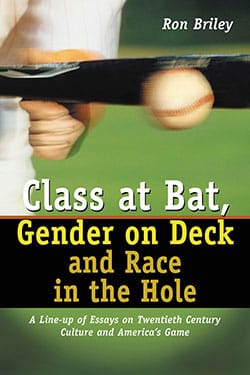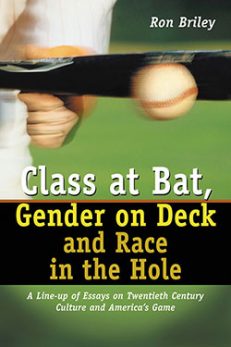Class at Bat, Gender on Deck and Race in the Hole
A Line-up of Essays on Twentieth Century Culture and America’s Game
$29.95
In stock
About the Book
Nineteen essays by Briley focus on major league baseball as it reflected the changing American culture from about 1945 to about 1980. He examines the era through the lens of race, gender and class—categories which have increasingly become essential analytical tools for scholars.
The accounts of Roman Mejias and Cesar Cedeno offer some disturbing insights regarding the acceptance of Latinos in baseball and American society. In one essay, Briley refers to baseball as the heart of the nation’s democratic spirit, noting that the son of a rural farmer could play alongside a governor’s son and both would receive only the praise that their playing merited. However, in writing about the Milwaukee Braves’move to Atlanta, the lamentations of fans—that baseball had succumbed to the age of affluence—are compared to the changing patterns of demographics and economic power in American society. Even with the increased participation of women on the field with teams like the Silver Bullets, the final essay comments on organized baseball’s perception of them as primarily spectators.
Instructors considering this book for use in a course may request an examination copy here.
About the Author(s)
Bibliographic Details
Ron Briley
Format: softcover (6 x 9)
Pages: 335
Bibliographic Info: notes, index
Copyright Date: 2003
pISBN: 978-0-7864-1590-8
eISBN: 978-1-4766-2975-9
Imprint: McFarland
Table of Contents
Acknowledgments vii
Preface 1
1 Ruth and Cobb as Cultural Symbols: The Development of a Mass Consumer Ethic in the 1920s 7
2 Don’t Let Hitler (or the Depression) Kill Baseball: FDR and the National Pastime (1932–1945) 23
3 Where Have You Gone William Bendix? Baseball as a Symbol of American Values in WWII 39
4 Amity Is the Key to Success: Baseball and the Cold War 55
5 Do Not Go Gently into That Good Night: Race, the Establishment, and the Retirements of Feller and Robinson 72
6 The Limits of Baseball Integration: Louisiana, the Texas League, and Shreveport (1956–1957) 84
7 Ten Years After: The Establishment, Race, and Robinson 93
8 More Legacy of Conquest: Long Term Ramifications of the Major League Shift to the West 107
9 The Houston Colt .45s: The Other Expansion Team of 1962 122
10 Milwaukee and Atlanta, a Tale of Two Cities: Eddie, Hank, and the Rover Boys Head South 140
11 The Times Were A-Changin’: Baseball as a Symbol of Values in Transition (1963–1964) 157
12 It Was 20 Years Ago Today: Baseball Responds to the Unrest of 1968 177
13 Baseball and America in 1969: A Traditional Institution Responds to Change 196
14 The A’s of 1972–75 and the Counterculture: Undermining the Hegemony of the Establishment 212
15 As American as Cherry Pie: Baseball and Reflections of Violence in the 1960s and 1970s 231
16 Roman Mejias: Houston’s First Major League Latin Star 250
17 Houston’s Latin Star Cesar Cedeno and Death in the Dominican Republic: The Troubled Legacy of Race Relations in the Lone Star State 266
18 The Albuquerque Dukes and the Summer of 1981: The Best Baseball in America 281
19 Baseball and the Women’s Question: Participation, Gender Stereotypes, and the Consumption Ethic 296
Index 317
Book Reviews & Awards
“analysis of the Houston franchise and its inability to deal with its Latino ballplayers is illuminating…deals intelligently with the evolution of the players’ union…makes some wise judgments about the conflicts”—Choice; “unique…an educational pleasure”—Crosswinds Weekly; “every essay is worth reading…enjoyable and informative reading”—Unholy Troika.





